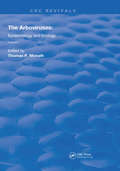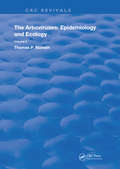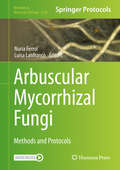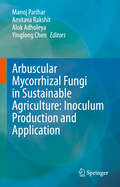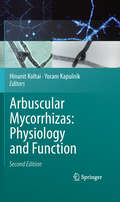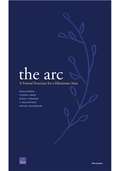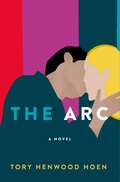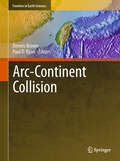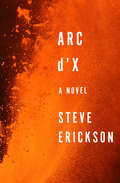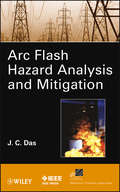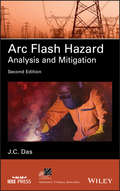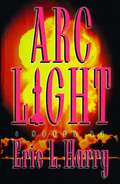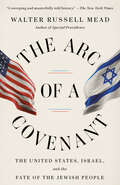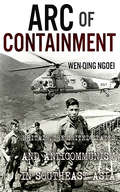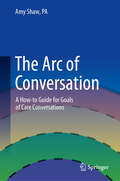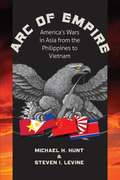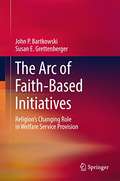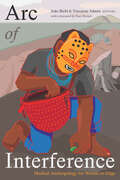- Table View
- List View
The Arboviruses: Epidemiology and Ecology (Routledge Revivals #1)
by Thomas P. MonathFirst Published in 1988, this five volume set documents the transmission and growth of Arthropod born viruses. Carefully compiled and filled with a vast repertoire of notes, diagrams, and references this book serves as a useful reference for Students of Epidemiology, and other practitioners in their respective fields.
The Arboviruses: Epidemiology and Ecology (Routledge Revivals #5)
by Thomas P. MonathFirst Published in 1988, this five volume set documents the transmission and growth of Arthropod born viruses. Carefully compiled and filled with a vast repertoire of notes, diagrams, and references this book serves as a useful reference for Students of Epidemiology, and other practitioners in their respective fields.
The Arboviruses: Epidemiology and Ecology (Routledge Revivals #2)
by Thomas P. MonathFirst Published in 1988, this five volume set documents the transmission and growth of Arthropod born viruses. Carefully compiled and filled with a vast repertoire of notes, diagrams, and references this book serves as a useful reference for Students of Epidemiology, and other practitioners in their respective fields.
Arbuscular Mycorrhizal Fungi: Methods and Protocols (Methods in Molecular Biology #2146)
by Nuria Ferrol Luisa LanfrancoThis book compiles the most comprehensive collection of protocols currently used in arbuscular mycorrhizal (AM) fungal research. This experience-based collection includes methods for isolation, cultivation, detection, and quantification of AM fungi, as well as the use of metagenomics for community studies and experimental procedures for functional genomics. Written for the highly successful Methods in Molecular Biology series, chapters include introductions to their respective topics, lists of the necessary materials and reagents, step-by-step, readily reproducible laboratory protocols, and tips on troubleshooting and avoiding known pitfalls. Authoritative and cutting-edge, Arbuscular Mycorrhizal Fungi: Methods and Protocols serves as an ideal aid for researchers seeking to perform experiments that fill the gaps in our knowledge of the basic biology, functions, and ecology of AM fungi in the hope of deploying these powerful plant fungal symbionts in agriculture more effectively.
Arbuscular Mycorrhizal Fungi: For Nutrient, Abiotic and Biotic Stress Management in Rice
by Periyasamy PanneerselvamArbuscular mycorrhizal fungi (AMF) are considered enormously important in contemporary agriculture and horticulture due to their important role in nutrient, biotic and abiotic stress management apart from enhancing plant health and soil fertility. AMF is one of the important fungi for soil aggregation, which helps in drought management. Hence this book brings out an exclusive text on AMF for sustainable rice production. It provides comprehensive up-to-date knowledge on AMF in rice cultivation, and for sustainable rice production in different ecologies without damaging the environment. Salient Features: 1. Covers all the aspects of AMF in rice cultivation from diversity to applications 2. Documents AMF diversity based on metagenomic approach in rice ecosystems 3. Explains the importance of AMF in soil aggregation, which helps in drought management 4. Provides new unraveling knowledge about AMF for sustainable rice production in different ecologies without damaging the environment 5. Discusses the AMF role in induction of resistance in rice plants against some pests.
Arbuscular Mycorrhizal Fungi and Higher Plants: Fundamentals and Applications
by Golam Jalal Ahammed Roghieh HajibolandThis book covers the fundamentals of arbuscular mycorrhizal fungi (AMF) and higher plant symbiosis with potential implications in crop production. It provides new insights into our understanding of the mechanisms of AMF-mediated plant growth regulation and stress tolerance covering the most recent biochemical, physiological, molecular, environmental, and ecological studies. Focusing on AMF-induced physiological and molecular mechanisms of enhanced tolerance to stress, environmental stress is discussed in several dedicated chapters. The book provides not only updated information with new insights and perspectives but also several new topics, such as a comprehensive discussion on biotic stressors, AMF interaction with other microorganisms, non-host plant species, plant secondary metabolism, signaling events in plant-AMF symbiosis, AMF-mediated nutrient acquisition and subsequent stress tolerance. The book also discusses the potential implications of AMF for sustainable crop production in the context of climate change. The book can be a useful reference book for academics and scientists involved in related research, such as academics in agronomy and plant sciences, scientists involved in beneficial fungi research, chemists, industrialists, and employees involved in the production and marketing of biofertilizers, master and doctoral degree students of agronomy, horticulture, and plant protection, consultants working on the production of crops in marginal environments as well as environmental scientists working for assisted phytoremediation programs. It would also be suitable for agronomy, ecology, and plant science-related courses, such as plant stress physiology, plant growth-promoting microbes, and plant pathology to teach undergraduate, graduate, and postgraduate students at colleges and universities.
Arbuscular Mycorrhizal Fungi in Sustainable Agriculture: Inoculum Production and Application
by Amitava Rakshit Manoj Parihar Alok Adholeya Yinglong ChenThis 2-volume book is an up-to-date overview of current progress in Arbuscular Mycorrhizal Fungal (AMF) technique development, inoculum production and its quality regulations, application in agriculture, horticulture, agroforestry, and other ecosystems, along with nutrient management for sustainable food production. It contains the current advancement in basic and molecular techniques, challenges, opportunities, and determinates of various AMF production methods and major tools and techniques for their field application. Production and development of AMF is rapidly evolving and requires a multidisciplinary approach with up-to-date knowledge to broaden and strengthen the perspective of researchers involved in this domain. The volumes offer new insight and cutting-edge information for novices and experts such as students, academicians, researchers, environmentalists, industrialists, and others interested in mycorrhiza. The first volume covers some basic isolation techniques, enumeration,and molecular studies with recent advances in various in-vitro and in-vivo production technologies, regulatory issues, and application methodologies for field inoculation. It also discusses AMF application in various agroecosystems for sustainable agricultural production and a healthier planet.
Arbuscular Mycorrhizal Fungi in Sustainable Agriculture: Nutrient and Crop Management
by Amitava Rakshit Manoj Parihar Alok Adholeya Yinglong ChenThis 2 volume book is an up-to-date overview of current progress in Arbuscular Mycorrhizal Fungal (AMF) technique development, inoculum production and its quality regulations, application in agriculture, horticulture, agroforestry and other ecosystems along with nutrient management for sustainable food production. It offers new insight and cutting-edge information for novices and experts such as students, academicians, researchers, environmentalists, industrialists, and other individuals interested in the field of mycorrhiza.AMF provides favorable rhizospheric environment to the plant with numerous direct and indirect mechanisms, in exchange of soil nutrients and photosynthetically fixed carbon. Other than the species composition and diversity determination of natural ecosystem, AMF play a vital role in maintaining the soil quality, agricultural sustainability and environmental integrity. The second volume provide comprehensive knowledge on AMF role in nutrient cycling, nutrient exchange and their acquisition under normal and stress condition.
Arbuscular Mycorrhizas: Physiology And Function
by Hinanit Koltai Yoram KapulnikIn the years since the first edition of "Arbuscular Mycorrhizas: Physiology and Function" was published, an exceptional proliferation of interest in mycorrhizal biology has developed. This has been associated with advances in different research disciplines such as genetics, genomics, proteomics, metabolomics and physiology, advances which have generated better insight into topics of mycorrhizal biology, including the mechanisms of host-mycorrhiza interactions pre- and post-penetration, the influence of the symbiosis on the host and its surroundings, and the evolution and diversity of mycorrhization. It therefore became necessary to both update and expand the book's coverage in this, its second edition.
Arbuscular Mycorrhizas and Stress Tolerance of Plants
by Qiang-Sheng WuThis book reviews the potential mechanisms in arbuscular mycorrhizas (AMs), in the hope that this can help arbuscular mycorrhizal fungi (AMF) to be more used efficiently as a biostimulant to enhance stress tolerance in the host plants. AMF, as well as plants, are often exposed to all or many of the abiotic and biotic stresses, including extreme temperatures, pH, drought, water-logging, toxic metals and soil pathogens. Studies have indicated a quick response to these stresses involving several mechanisms, such as root morphological modification, reactive oxygen species change, osmotic adjustment, direct absorption of water by extraradical hyphae, up-regulated expression of relevant stressed genes, glomalin-related soil protein release, etc. The underlying complex, multi-dimensional strategy is involved in morphological, physiological, biochemical, and molecular processes. The AMF responses are often associated with homeostatic regulation of the internal and external environment, and are therefore critical for plant health, survival and restoration in native ecosystems and good soil structure.
The Arc
by C. Ross Anthony Michael Schoenbaum Doug Suisman Steven Simon Glenn RobinsonAn examination of options for strengthening the housing and transportation infrastructure of a potential future independent Palestinian state in the context of a large and rapidly growing Palestinian population. The book includes initial cost estimates for improving and expanding infrastructure to facilitate successful development.
The Arc: A Novel
by Tory Henwood Hoen"A thoroughly modern love story with an old-fashioned heart."––Vogue“Sure to satisfy fans of Taylor Jenkins Reid and Sally Rooney.”––E! Online"Funny and modern, The Arc is like a rom-com’s cooler big sister."––Real SimpleCan you curate your soulmate? Thirty-five-year-old Ursula Byrne, VP of Strategic Audacity at a branding agency in Manhattan, is successful, witty, whip-smart, and single. She’s tried all the dating apps, and let’s just say: she’s underwhelmed by her options. You’d think that by now someone would have come up with something more bespoke; a way for users to be more tailored about who and what they want in a life partner––how hard could that be?Enter The Arc: a highly secretive, super-sophisticated matchmaking service that uses a complex series of emotional, psychological and physiological assessments to architect partnerships that will go the distance. The price tag is high, the promise ambitious––a level of lifelong compatibility that would otherwise be unattainable. In other words, The Arc will find your ideal mate.Ursula is paired with forty-two-year-old lawyer Rafael Banks. From moment one, this feels like the electric, lasting love they’ve each been seeking their whole adult lives. But as their relationship unfolds in unanticipated ways, the two begin to realize that true love is never a sure thing. And the arc of a relationship is never predictable...even when it's fully optimized.
The Arc (The Loop)
by Ben OliverIn the final installment of critically acclaimed Loop trilogy, all of humanity hinges on the greatest escape yet.All hope has seemingly been executed.Despite the fact that the truth of their oppressive leaders had been revealed to them, the crowd of Alts cheer as life drained from the boy. But one Alt, Chester “Chilly” Beckett, did not celebrate; his eyes have been opened to the truth. The corpse is dragged away, but Chester remains determined to find out what is going on in the Laboratory on the 65th floor.There, he'll find three subjects tortured in an attempt to extract a regeneration formula… and one of the subjects is, impossibly, a face he never thought he'd seen again. A bold escape sets in motion a race against time as Happy’s plans to release planet-eating nano-bots into the world draw nearer. The Loop team must reassemble, survive Happy’s final attempts to rid the world of the rebels, and figure out how to halt the apocalypse before humanity is destroyed.
Arc-Continent Collision (Frontiers in Earth Sciences)
by Dennis Brown Paul D. RyanArc-continent collision has been one of the important tectonic processes in the formation of mountain belts throughout geological time, and it continues to be so today along tectonically active plate boundaries such as those in the SW Pacific or the Caribbean. Arc-continent collision is thought to have been one of the most important process involved in the growth of the continental crust over geological time, and may also play an important role in its recycling back into the mantle via subduction. Understanding the geological processes that take place during arc-continent collision is therefore of importance for our understanding of how collisional orogens evolve and how the continental crust grows or is destroyed. Furthermore, zones of arc-continent collision are producers of much of the worlds primary economic wealth in the form of minerals, so understanding the processes that take place during these tectonic events is of importance in modeling how this mineral wealth is formed and preserved. This book brings together seventeen papers that are dedicated to the investigation of the tectonic processes that take place during arc-continent collision. It is divided into four sections that deal firstly with the main players involved in any arc-continent collision; the continental margin, the subduction zone, and finally the volcanic arc and its mineral deposits. The second section presents eight examples of arc-continent collisions that range from being currently active through to Palaeoproterozoic in age. The third section contains two papers, one that deals with the obduction of large-slab ophiolites and a second that presents a wide range of physical models of arc-continent collision. The fourth section brings everything that comes before together into a discussion of the processes of arc-continent collision.
Arc d'X: A Novel
by Steve EricksonIn a desperate effort to liberate herself, a fourteen-year-old slave—mistress to the man who invented America—finds herself flung into a different time and worldSteve Erickson&’s provocative reimagining of American history, Arc d&’X begins with the relationship between Thomas Jefferson and Sally Hemings. With &“skin . . . too white to be quite black and too black to be quite white,&” Sally is loved only to the extent that she can be possessed, and finds hope only in the promise that her children&’s lives will be different from her own. The couple&’s paradox-riven union echoes through the ages and in an alternate epoch where time plays by other rules. In Aeonopolis, a theocratic city at the foot of a volcano, priests seek to have Sally indicted, and in an emptied-out Berlin, the Wall is being rebuilt. Dizzyingly imaginative, Arc d&’X is an unrivaled exploration of &“the pursuit of happiness.&”
ARC Flash Hazard Analysis and Mitigation (IEEE Press Series on Power Engineering #91)
by J. C. DasUp-to-date analysis methodologies and practical mitigation for a major electrical safety concern Arc Flash Hazard Analysis and Mitigation is the first book to focus specifically on arc flash hazards and provide the latest methodologies for its analysis as well as practical mitigation techniques. Consisting of sixteen chapters, this fully up-to-date handbook covers all aspects of arc flash hazard calculations and mitigation. It addresses the calculations of short circuits, protective relaying, and varied electrical systems configurations in electrical power systems. It also examines protection systems, including differential relays, arc flash sensing relays, protective relaying coordination, current transformer operation and saturation, and applications to major electrical equipment from the arc flash point of view. Current technologies and strategies for arc flash mitigation are explored. Using the methodology, analysis, and preventive measures discussed in the book, the arc flash hazard incident energy can be reduced to 8 cal/cm2 or less for the new and existing electrical distribution systems. This powerful resource: Features the most up-to-date arc flash analysis methodologies Presents arc flash hazard calculations in dc systems Supplies practical examples and case studies Provides end-of-chapter reviews and questions Includes a Foreword written by Lanny Floyd, a world-renowned leader in electrical safety who is DuPont's Principal Consultant on Electrical Safety and Technology Arc Flash Hazard Analysis and Mitigation is a must-have guide for electrical engineers engaged in design, operation, and maintenance, consulting engineers, facility managers, and safety professionals.
Arc Flash Hazard Analysis and Mitigation (IEEE Press Series on Power and Energy Systems #91)
by J. C. DasThis new edition of the definitive arc flash reference guide, fully updated to align with the IEEE's updated hazard calculations An arc flash, an electrical breakdown of the resistance of air resulting in an electric arc, can cause substantial damage, fire, injury, or loss of life. Professionals involved in the design, operation, or maintenance of electric power systems require thorough and up-to-date knowledge of arc flash safety and prevention methods. Arc Flash Hazard Analysis and Mitigation is the most comprehensive reference guide available on all aspects of arc flash hazard calculations, protective current technologies, and worker safety in electrical environments. Detailed chapters cover protective relaying, unit protection systems, arc-resistant equipment, arc flash analyses in DC systems, and many more critical topics. Now in its second edition, this industry-standard resource contains fully revised material throughout, including a new chapter on calculation procedures conforming to the latest IEEE Guide 1584. Updated methodology and equations are complemented by new practical examples and case studies. Expanded topics include risk assessment, electrode configuration, the impact of system grounding, electrical safety in workplaces, and short-circuit currents. Written by a leading authority with more than three decades' experience conducting power system analyses, this invaluable guide: Provides the latest methodologies for flash arc hazard analysis as well practical mitigation techniques, fully aligned with the updated IEEE Guide for Performing Arc-Flash Hazard Calculations Explores an inclusive range of current technologies and strategies for arc flash mitigation Covers calculations of short-circuits, protective relaying, and varied electrical system configurations in industrial power systems Addresses differential relays, arc flash sensing relays, protective relaying coordination, current transformer operation and saturation, and more Includes review questions and references at the end of each chapter Part of the market-leading IEEE Series on Power Engineering, the second edition of Arc Flash Hazard Analysis and Mitigation remains essential reading for all electrical engineers and consulting engineers.
Arc Light
by Eric HarryIn a scenario terrifyingly close to today's headlines, Harry's debut novel opens with a North Korean invasion of South Korea that leads, through a series of tragic errors and decisions, to a Russian nuclear attack on military bases in the US. Like techno-thriller master Tom Clancy, Harry offers a sprawling narrative that focuses on a small army of soldiers, politicians, and their families, American and Russian. National Security Advisor Greg Lambert must keep and tell secrets that may lead to Armageddon; Reservist David Chandler must leave his pregnant wife in order to drive a tank; US President Walter Livingston, eager for peace, must endure the ignominy of impeachment; Russian General Yuri Razov must deal with the consequences of his initial decision to launch nuclear missiles. Ground, air, and submarine battles alternate with scenes of anarchy stateside as exhausted leaders are forced to make instant decisions that might snuff out humanity forever. With a masterful grasp of military strategy and geopolitics, Harry moves his characters through nightmares of blood and death; his intricately detailed scenes of nuclear devastation are particularly horrifying. Told through a series of rapid-fire climaxes, this novel, a political and military cautionary tale of considerable power and conviction, will keep readers riveted.
The Arc of a Covenant: The United States, Israel, and the Fate of the Jewish People
by Walter MeadA NEW YORK TIMES BEST BOOK OF THE YEAR • A groundbreaking work that overturns the conventional understanding of the Israeli-American relationship and, in doing so, explores how fundamental debates about American identity drive our country's foreign policy.In this bold examination of the Israeli-American relationship, Walter Russell Mead demolishes the myths that both pro-Zionists and anti-Zionists have fostered over the years. He makes clear that Zionism has always been a divisive subject in the American Jewish community, and that American Christians have often been the most fervent supporters of a Jewish state, citing examples from the time of J.P. Morgan and John D. Rockefeller to the present day.He spotlights the almost forgotten story of left-wing support for Zionism, arguing that Eleanor Roosevelt and liberal New Dealers had more influence on President Truman's Israel policy than the American Jewish community--and that Stalin's influence was more decisive than Truman's in Israel's struggle for independence. Mead shows how Israel's rise in the Middle East helped kindle both the modern evangelical movement and the Sunbelt coalition that carried Reagan into the White House. Highlighting the real sources of Israel's support across the American political spectrum, he debunks the legend of the so-called "Israel lobby." And, he describes the aspects of American culture that make it hostile to anti-Semitism and warns about the danger to that tradition of tolerance as our current culture wars heat up.With original analysis and in lively prose, Mead illuminates the American-Israeli relationship, how it affects contemporary politics, and how it will influence the future of both that relationship and American life.
Arc of Containment: Britain, the United States, and Anticommunism in Southeast Asia (The United States in the World)
by Wen-Qing NgoeiArc of Containment recasts the history of American empire in Southeast and East Asia from World War II through the end of American intervention in Vietnam. Setting aside the classic story of anxiety about falling dominoes, Wen-Qing Ngoei articulates a new regional history premised on strong security and sure containment guaranteed by Anglo-American cooperation.Ngoei argues that anticommunist nationalism in Southeast Asia intersected with preexisting local antipathy toward China and the Chinese diaspora to usher the region from European-dominated colonialism to US hegemony. Central to this revisionary strategic assessment is the place of British power and the effects of direct neocolonial military might and less overt cultural influences based in decades of colonial rule. Also essential to the analysis in Arc of Containment is the considerable influence of Southeast Asian actors upon Anglo-American imperial strategy throughout the post-war period. In Arc of Containment Ngoei shows how the pro-US trajectory of Southeast Asia after the Pacific War was, in fact, far more characteristic of the wider region's history than American policy failure in Vietnam. Indeed, by the early 1970s, five key anticommunist nations—Malaya, Singapore, Philippines, Thailand, and Indonesia—had quashed Chinese-influenced socialist movements at home and established, with U.S. support, a geostrategic arc of states that contained the Vietnamese revolution and encircled China. In the process, the Euro-American colonial order of Southeast Asia passed from an era of Anglo-American predominance into a condition of US hegemony. Arc of Containment demonstrates that American failure in Vietnam had less long-term consequences than widely believed because British pro-West nationalism had been firmly entrenched twenty-plus years earlier. In effect, Ngoei argues, the Cold War in Southeast Asia was but one violent chapter in the continuous history of western imperialism in the region in the twentieth century.
The Arc of Conversation: A How-to Guide for Goals of Care Conversations
by Amy Shaw, PAIntending to fill an important gap in medical training, this book presents an easy-to-learn, standardized approach to having compassionate and collaborative goals of care conversations with patients and families, a skill that can be difficult for clinicians to learn and that is not part of standard medical education curricula. Developed by a Palliative Care provider, this is the first book to teach everything clinicians need to know to gently guide patients and families through what can often be difficult discussions about illness, disease, end-of-life wishes, and hospice care. This technique can be used to discuss any medical diagnosis or treatment, be employed at any age or stage of an illness, and can be used by health care professionals at any level. Readers will be introduced to the patterns of decline patients follow toward the end of life, criteria for recognizing when a patient’s time is limited, hospice care, ground rules for compassionate communication, and a step-wise method of leading patients and families through difficult goals of care conversations in a collaborative way. The book includes specific questions to ask and starter language clinicians can use for developing their own patient-friendly talking points about disease progression, the end of life, concerns that a patient’s time is limited, advanced directives, code status, and hospice care. An Arc of Conversation Guide, for use when learning this technique, is also included. While modern medicine is terrific at acute stabilization of illness or injury, it often ignores the elephant in the room—disease progression and death. By doing so, the healthcare system frequently misses opportunities to align patient wishes with the care they receive. Furthermore, physicians often avoid difficult conversations with patients due to a lack of training or the assumption that hospice care represents medical or personal failure. Incorporating the material and technique taught in The Arc of Conversation into everyday practice will enable clinicians to acknowledge and discuss patient decline and to confidently include hospice care as a viable option for treatment that can support patient values, wishes, and priorities. Moving toward a continually collaborative approach with patients—a shift away from physician-directed care to patient-centered care—will enable clinicians to develop treatment plans that prioritize outcomes that matter most to patients and families, improving patient and family experience of health care across their lives and providing patients with the ‘soft landing’ they want at the end.
Arc of Empire
by Michael H. Hunt Steven I. LevineAlthough conventionally treated as separate, America's four wars in Asia were actually phases in a sustained U.S. bid for regional dominance, according to Michael H. Hunt and Steven I. Levine. This effort unfolded as an imperial project in which military power and the imposition of America's political will were crucial. Devoting equal attention to Asian and American perspectives, the authors follow the long arc of conflict across seventy-five years from the Philippines through Japan and Korea to Vietnam, tracing along the way American ambition, ascendance, and ultimate defeat. They show how these wars are etched deeply in eastern Asia's politics and culture.The authors encourage readers to confront the imperial pattern in U.S. history with implications for today's Middle Eastern conflicts. They also offer a deeper understanding of China's rise and Asia's place in today's world.For instructors: An Online Instructor's Manual is available, with teaching tips for using Arc of Empire in graduate and undergraduate courses on America's wars in Asia. It includes lecture topics, chronologies, and sample discussion questions.
The Arc of Faith-Based Initiatives: Religion's Changing Role In Welfare Service Provision
by John P. Bartkowski Susan E. GrettenbergerAnalyzes the activities of faith-based organizations in Mississippi, Michigan, and the Pacific Northwest.<p><p> Compares services delivered by faith-based organizations and secular agencies.<p> Examines family support, transitional homeless, and addiction recovery programs.<p> Offers an in-depth analysis of the topic with rich qualitative data.<p>This volume offers an in-depth examination of a diverse range of faith-based programs implemented in three different geographical locales: family support in rural Mississippi, transitional housing in Michigan, and addiction recovery in the Pacific Northwest (Washington-Oregon). Various types of religious service providers—faith-intensive and faith-related—are carefully examined, and secular organizations also serve as an illuminating point of comparison. Among other insights, this book reveals how the “three C’s” of social service provision—programmatic content, organizational culture, and ecological context—all combine to shape the delivery of welfare services in the nonprofit world. This book warns against simplistic generalizations about faith-based organizations. Faith-based providers exhibit considerable diversity and, quite often, remarkable resilience in the face of challenging social circumstances. An appreciation of these nuances is critical as policies concerning faith-based organizations continue to evolve.
Arc of Interference: Medical Anthropology for Worlds on Edge (Critical Global Health: Evidence, Efficacy, Ethnography)
by João Biehl and Vincanne AdamsThe radically humanistic essays in Arc of Interference refigure our sense of the real, the ethical, and the political in the face of mounting social and planetary upheavals. Creatively assembled around Arthur Kleinman’s medical anthropological arc and eschewing hegemonic modes of intervention, the essays advance the notion of a care-ful ethnographic praxis of interference. To interfere is to dislodge ideals of naturalness, blast enduring binaries (human/nonhuman, self/other, us/them), and redirect technocratic agendas while summoning relational knowledge and the will to create community. The book’s multiple ethnographic arcs of interference provide a vital conceptual toolkit for today’s world and a badly needed moral perch from which to peer toward just horizons.Contributors. Vincanne Adams, João Biehl, Davíd Carrasco, Lawrence Cohen, Jean Comaroff, Robert Desjarlais, Paul Farmer, Marcia Inhorn, Janis H. Jenkins, David S. Jones, Salmaan Keshavjee, Arthur Kleinman, Margaret Lock, Adriana Petryna
